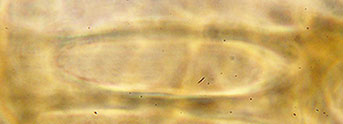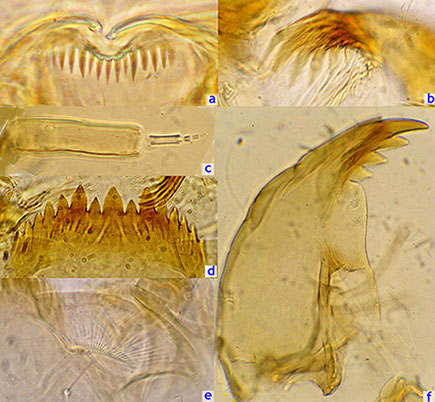C. javanus immaturesFourth instar larva: Information from Chaudhuri et al. (1992) supplemented by data of 3 larvae from India.
Medium sized essentially melanotus-type larva (length 11.59 (10.3-13.7) mm (10), although lateral tubules are more ventrally placed than in other species. Chaudhuri et al. (1992) show the ventral tubules arising very close together (although this is unusual) anterior pair longer. Anal tubules variable about 300 (210-370) micron long with no constriction, ventral pair longer and narrower (3.1 times longer than wide).Ventral head length 322 (310.5-335.5) µm. Gula sometimes slightly darkened, wider than the mentum and widest at the base. Salivary reservoir (below) about 73 (68-78) µm wide and 3.9-4.4 times wider than deep.  Mentum (Fig. d, below) with the central trifid tooth of type IIA, i.e. c1 tooth quite broad and c2 teeth markedly separated from c1 tooth; 4th laterals usually not reduced (type I). but are in the specimen from Madurai. Although basically similar to that of C. vitellinus, this central trifid tooth does not arise noticeably below the 1st laterals.Ventromental plates (Fig. e, below) separated by about 0.30-0.39 of the mentum width; about 186.5 (176-199) µm wide and 3.8 (3.66-4.02) times wider than deep and about same width as the mentum; about 33.5 (32-35) relatively widely spaced striae; VMR about 0.33.PE (Fig. a, below) with about 15.6 (14-17) teeth (type A, although the illiustration of Chaudhuri et al., suggests they are type B).Distance between the antennal bases less or similar to that between the S4 setae which are separated by about 82-84% of the FC width at that point.Antenna (Fig. c, below) with the basal segment 1/3 of VHL, about 2.8-3.6 times longer than wide and about 0.3-0.37 of the VHL; AR about 2.35 (1.95-2.67), ratio of segments 109 : 27.5 : 5 : 6 : 6. Ring organ about 26-37% up from base of segment I.Premandible (Fig. b, below) with 6 teeth, reducing in size from outer to inner.Mandible (Fig. f, below) about 207 (190-230) µm long with third inner tooth mostly completely separated but only slightly darkened (type ii-IIIA), about 14.2 (13-15) furrows on outer surface at base; 11 (9-12) taeniae in Pecten mandibularis, Mdt-Mat 26.2 (22.5-28) µm, MTR 0.39 (0.33-0.46). Mentum (Fig. d, below) with the central trifid tooth of type IIA, i.e. c1 tooth quite broad and c2 teeth markedly separated from c1 tooth; 4th laterals usually not reduced (type I). but are in the specimen from Madurai. Although basically similar to that of C. vitellinus, this central trifid tooth does not arise noticeably below the 1st laterals.Ventromental plates (Fig. e, below) separated by about 0.30-0.39 of the mentum width; about 186.5 (176-199) µm wide and 3.8 (3.66-4.02) times wider than deep and about same width as the mentum; about 33.5 (32-35) relatively widely spaced striae; VMR about 0.33.PE (Fig. a, below) with about 15.6 (14-17) teeth (type A, although the illiustration of Chaudhuri et al., suggests they are type B).Distance between the antennal bases less or similar to that between the S4 setae which are separated by about 82-84% of the FC width at that point.Antenna (Fig. c, below) with the basal segment 1/3 of VHL, about 2.8-3.6 times longer than wide and about 0.3-0.37 of the VHL; AR about 2.35 (1.95-2.67), ratio of segments 109 : 27.5 : 5 : 6 : 6. Ring organ about 26-37% up from base of segment I.Premandible (Fig. b, below) with 6 teeth, reducing in size from outer to inner.Mandible (Fig. f, below) about 207 (190-230) µm long with third inner tooth mostly completely separated but only slightly darkened (type ii-IIIA), about 14.2 (13-15) furrows on outer surface at base; 11 (9-12) taeniae in Pecten mandibularis, Mdt-Mat 26.2 (22.5-28) µm, MTR 0.39 (0.33-0.46). 
Larval mouthparts of a larva of C. javanus from Jammu, IndiaThe larva is most readily recognised by the unusual premandible (fig.b, above), which has 6 (as illustrated by Chaudhuri et al. (1992) for Indian specimens) rather than the usual two. However, specimens have been described from Malaysia and Singapore (e.g. Kuvangkadilok 1969) where the premandible has a normal premandible with only two teeth. The identity of these specimens is unclear (Martin 2022).Pupa: The only description reliably attached to C. javanus is by Chaudhuri et al. (1992).
Length: Male 6.40 (6.38-6.70) mm; female 7.01 (6.90-7.14) mm (6-7 mm in Lenz 1937).
Brown; exuviae grey. Cephalic tubercles 0.10-0.11 long and 0.06-0.07 in diameter, subapical seta 0.09-0.10 long, i.e. about as long as the tubercles. Respiratory base about 0.11-0.14 wide. 2 pairs of precorneal setae.
Abdomen with Pedes spurii A caudolateral on segments IV-VI, Pedes spurii B basolateral on segment I and caudolateral on segment II, which also bears a caudal row of about 66-70 hooks.
Tergites II-V with median shagreen;tergite VII with complete shagreen and segment VIII with median shagreen interrupted medially.
Caudolateral spur of segment VIII with 1 long and 1 short spine. Swim fin with numerous taeniae apparently in a single row. [ Return to Index| Go to C. javanus ] |

